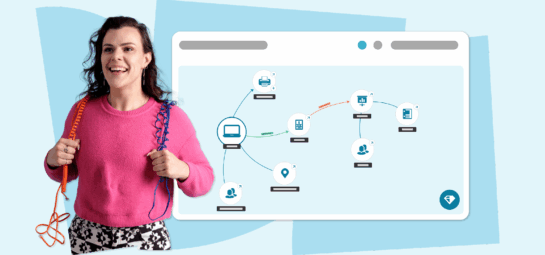How internal IT ticketing systems improve ticket routing for HR and facilities

Imagine this: Your IT team is doing its best to juggle service requests, system errors, and equipment problems — but the tool meant to help them feels more like a hurdle. Tickets pile up in the same queue, business users grow frustrated, and teams scramble to manage expectations without clear processes. It’s a familiar scene for many organizations that rely on generic helpdesk software for internal support.
The truth is, while internal helpdesk software might look similar to customer-facing tools on the surface, what happens behind the scenes is very different. Internal IT teams need systems designed for their unique workflows, priorities, and stakeholders. This is where an internal IT ticketing system makes all the difference.
The Problem with customer service tools for internal support
Many well-known platforms, such as Zendesk, have their roots in customer service. They’re built to handle external queries, prioritize customer satisfaction (CSAT), and support sales enablement. And while some vendors claim their tools can handle internal support, too, the cracks tend to show fast.
Here’s what goes wrong when using tools designed for customers to manage your internal IT:
- Misaligned workflows. Generic helpdesks are often optimized for simple customer inquiries. On the other hand, internal IT needs to manage complex incidents, prioritize based on business impact, and route tickets across multiple departments such as HR and Facilities.
- Wrong success metrics. External platforms focus on CSAT and first-contact resolution, which is great for customer service but not helpful when measuring internal service level agreements (SLAs) or tracking internal service performance over time.
- Limited cross-department support. When internal departments like HR or Facilities need to work together with IT, generic helpdesks rarely provide the flexibility or integrations required. This leads to shadow systems, disconnected workflows, and much manual effort.
- ITSM vs. CRM confusion. Many IT teams try to bend Customer Relationship Management (CRM) systems into IT Service Management (ITSM) workflows, creating chaos and inefficiency.
The result? Service teams are stuck in a loop of reactive firefighting and are unable to elevate their role within the organization. Over time, this erodes trust, hampers productivity, and drains team morale.
Why internal IT ticketing systems work better
Purpose-built internal IT ticketing systems are designed to fit how internal teams work. Here’s why they’re essential:
- Align with internal SLAs. These systems are built to support internal service expectations, not customer-facing KPIs. This means your team can focus on what matters: keeping the business running smoothly and meeting your own internal benchmarks.
- Enable Enterprise Service Management. Enterprise Service Management tools extend ITSM processes beyond IT, allowing HR, Facilities, and other service departments to use the same platform and thus creating seamless, cross-functional workflows.
- Better ticket routing for HR and Facilities. Purpose-built systems allow smart routing based on internal service categories, not just external product lines.
- Designed for ITSM processes. These systems natively support Incident, Change, and Problem Management — essential pillars of ITSM that CRM tools simply can’t replicate.
When internal teams have tools that fit their needs, they can shift from reactive ticket handlers to strategic partners in the business.
Hidden costs of using the wrong tool for internal IT
Sticking with a customer service platform for internal IT might seem like the path of least resistance. After all, the licenses are in place, and teams have learned to work around their limitations. However, these workarounds often carry hidden costs that chip away at productivity and budget over time.
Without a purpose-built internal IT ticketing system, teams waste hours manually rerouting tickets, duplicating work across disconnected tools, or fixing mistakes caused by poor visibility into assets and users. These inefficiencies add up to lost time, frustrated employees, missed internal SLAs, and unnecessary escalations.
And then there’s the cost of missed opportunities. When IT teams are stuck firefighting due to poor tools, they have less capacity to focus on strategic projects that could drive innovation, optimize processes, or improve employee experience.
By switching to an ITSM-first solution like TOPdesk, organizations remove these friction points. They empower IT and other internal teams to work smarter, automate the routine, and spend more time adding real value to the business. In short, the right system removes these friction points and gives your teams more capacity to focus on work that drives business impact.
How TOPdesk supports internal service teams
Unlike platforms that try to stretch customer service tools into internal use cases, TOPdesk for internal support is purpose-built for ITSM. But it doesn’t stop at IT — it naturally supports other internal departments, creating a unified, organization-wide service ecosystem.
ITSM-first design
TOPdesk is grounded in 30 years of ITSM experience, providing features that reflect best practices without forcing teams into rigid processes. IT teams, HR, Facilities, and more can all work within the same system while tailoring workflows to fit their specific needs — without writing a single line of code. And when your workflows need fine-tuning, TOPdesk’s services and consultancy teams are ready to help you adjust the system to your needs without long projects or extra complexity.
Self-Service Portal to reduce ticket load
The TOPdesk Self-Service Portal empowers employees to log requests, find answers, and track progress — all in one place. This improves the employee experience and frees IT teams to focus on more strategic work.
Flexible integrations and API-driven automation
TOPdesk supports over 100 integrations and offers API-driven automation, ensuring that IT teams can connect existing systems without complex workarounds.
Explore why APIs provide more flexibility than macros.
Real support from real people
TOPdesk’s local support teams use TOPdesk themselves — so when you reach out, you’re speaking to experts who know the system inside and out. With 75% of support tickets resolved within 24 hours, customers appreciate how reliable and responsive the team is. A TrustRadius reviewer said, “Even on Friday 5:00 PM, they will assist you with any problems.”
A quick look at TOPdesk vs. Zendesk for internal teams
TOPdesk and Zendesk often land in IT tool debates, but scratch the surface and their differences become impossible to ignore. While Zendesk might suit customer-facing teams, it falls short of internal ITSM needs. Zendesk’s strength lies in external support, while TOPdesk focuses squarely on ITSM, enabling seamless internal workflows and Enterprise Service Management tools.
Zendesk users often report plugin failures, slow response times, and rigid workflows that frustrate IT teams. G2 reviews reflect this, too, with one user noting, “I have worked with three organizations recently who are leaving Zendesk for another tool due to the lack of native support for ITSM.”
Organizations serious about ITSM and giving their internal teams the tools they deserve choose platforms like TOPdesk built for internal support from day one.
Read our blog to see how TOPdesk compares to ServiceNow.
Key reasons to make the switch
An internal IT ticketing system helps teams move beyond managing technology to focus on supporting the business where it matters most. Here’s why switching to an internal-focused ITSM tool is a smart move:
- Reduce downtime and manual errors. Automating ticket routing and ensuring the right team gets the proper request minimizes delays and avoids workarounds.
- Improve reporting and transparency. Get insights that matter to internal teams, from SLA compliance to department-specific performance metrics.
- Support the whole organization. With Enterprise Service Management tools, you create one service portal for all departments, improving the employee experience and breaking down silos.
- Avoid outgrowing your tool. Zendesk might work initially, but organizations looking for long-term ITSM maturity often switch to tools like TOPdesk.
Key Takeaways
- Generic customer service tools often fall short for internal IT support, leading to misaligned workflows, inefficient ticket routing, and poor cross-department collaboration.
- Internal IT ticketing systems like TOPdesk are purpose-built for ITSM, supporting internal SLAs, incident and change management, and enterprise-wide service needs across IT, HR, and Facilities.
- Using the wrong tool results in hidden costs, such as lost productivity, duplicate work, and missed opportunities for innovation and strategic IT contributions.
- TOPdesk offers a unified, scalable platform with self-service portals, flexible integrations, and real human support, empowering internal teams to move beyond firefighting and deliver long-term value.
Next steps: Give your internal teams the tools they deserve
If your IT team is still working with a tool built for customers, now’s the time to change that. Start by evaluating how your current system handles internal workflows. Are your metrics aligned with business goals? Can your HR or Facilities teams use the same platform? Do your employees have an intuitive place to request services?
TOPdesk’s IT Service Management Platform is designed to help teams move past firefighting and into strategic service delivery. Explore our ITSM platform and see how it can support your organization’s internal service needs from day one.
Book your free personalized demo to see how TOPdesk simplifies internal IT support across departments.
Inspire others, share this blog


